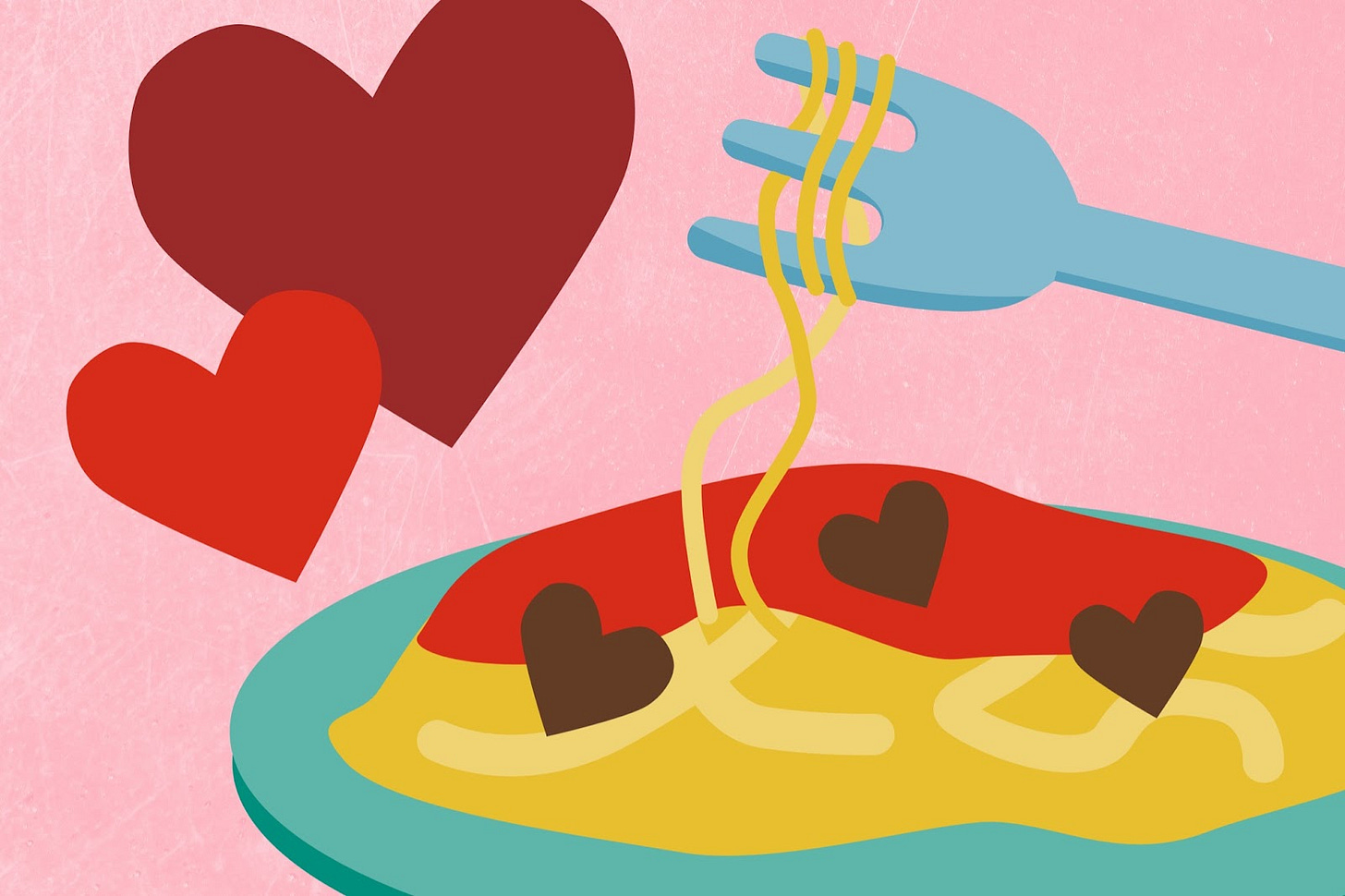Recipe for Love: the Role of Food in Romantic Stories
The secret language of food in the romance genre
One of the most classic images of romance on film is in Disney’s 1955 animated film, Lady and the Tramp. You know the scene: Lady and Tramp sit at Tony’s Restaurant, and are served a big plate of spaghetti to share. They each take a bite, unknowingly chewing on the same noodle, until their snouts touch in a “kiss” as “Bella Notte” plays. Tramp then noses the last meatball over to Lady, an act of generosity in their budding romance.
In the classic friends-to-lovers romcom When Harry Met Sally, the protagonists share a meal at Katz’s Deli in New York City, where they argue over a key difference between men and women when it comes to how they communicate in the bedroom. It’s one of the most famous scenes in cinematic history, when director Rob Reiner’s mother, cast as a fellow diner, simply says “I’ll have what she’s having.”
Food can be used as a kind of secret language in romance and romantic storylines, and is central to so many of our favorite movies and TV shows. Love stories often center around food in some way, whether it be a moment of connection or a plot in which an eatery or one’s profession in the food industry is key to the story. We’ve pulled together some examples, but by no means is this list exhaustive. We’d love to hear about your favorite romantic plotlines involving culinary experiences in the comments!
Yes, Chef! Love in and out of the kitchen
There are countless movies and TV shows where a protagonist is a chef or the love takes place in and around an eatery of some kind. In some stories, the food itself becomes a metaphor for the sweetness and indulgence of love. The classic romantic film Chocolat (2000)–based on the novel by Joanne Harris–is set in a quiet French village in 1959 where Vianne Rocher, a free-spirited chocolatier, opens a chocolate shop. The catch is that she opens the shop during the Christian season of Lent, challenging the town’s strict moral traditions, and setting the scene for rule-breaking–always a great setup for romance. Her confections awaken the villagers’ passions and bring joy, but her presence stirs conflict with the conservative mayor. She meets Roux, a charismatic traveler, and together they share a mutual attraction. All the while, chocolate becomes a symbol of indulgence and passion, rekindling the spark in the lives of other characters.
A kitchen can be a sanctuary for a chef from the pain of life: the structure and order (or organized chaos) is a salve from characters’ difficulty with romance and relationships among other things. In the 2007 film No Reservations, chef Kate is a perfectionist whose structured life is upended when she becomes the guardian of her young niece after a family tragedy. But the arrival of Nick, a charming and free-spirited sous-chef, proves to be the biggest interruption, as he teaches her to embrace spontaneity, both inside the kitchen and out.
In the Netflix original series Emily in Paris, the title character is an American who lands a marketing job in Paris, and it’s not long before she becomes acquainted with Gabriel, the hunky, successful chef who is also her neighbor. His restaurant is the site of so much of the drama–including Emily’s realization that he isn’t single, though the two are mutually attracted. His French cooking, flair for flavor, and dedication to the sensuality of food hardly helps her predicament (or the viewers’, if we’re being honest).
Like Water for Chocolate (1992), based on the novel by Laura Esquivel, is a magical realism film set in early 20th-century Mexico. Tita is a young woman forbidden to marry her true love, Pedro, because of her family's tradition that the youngest daughter must remain unmarried to care for her mother. Tita expresses her suppressed emotions through her cooking, which has magical effects on those who eat her dishes.
In the TV series Gilmore Girls, two of the show’s main couples come together in part because of food. The fast talking Lorelai Gilmore and her daughter Rory are almost always at the local diner, owned and operated by Luke Danes who, every day, feeds them burgers, pancakes, muffins, coffee (and hardly ever a vegetable). Luke’s Diner is where, over many seasons, viewers watch Luke and Lorelai fall in love–mostly with a lot of bickering as he serves her daily meals. On their first date, Luke takes Lorelai to his own local diner joint where the owners know his name–his own “Luke’s”- signifying that having a restaurant that feels like home is a perfect environment to be oneself and, in turn, open up to others.
Similarly, Sookie St. James, Lorelai’s business partner and chef at the local inn she manages, meets her romantic partner through food. Jackson is the local produce supplier, and sells his goods to the inn. Jackson and Sookie connect over fresh fruits and vegetables–sometimes even fighting about it–but their love and appreciation for quality ingredients for Sookie’s incredible creations is what brings them together. They make a major decision about their relationship over a picnic basket lunch–full of Sookie’s cooking, of course.
And in Waitress, both the movie and musical version, diner waitress Jenna bakes imaginative pies every day to “serve her worries away” as the song in the musical goes. But her gift for confection leads to a romance with her married doctor, Jim. While this romance might be misguided, it certainly leads Jenna to a new way of looking at the world–and her gift eventually leads her to a better life.
Still, a person’s status as a chef in a romantic movie can be a deterrent to the love connection. In Always Be My Maybe, Marcus and Sasha–childhood friends who had a brief romance–lose touch in their adulthood. They grow apart and their lives take different turns, and Sasha becomes a famous celebrity chef. When Sasha returns to their home city to open a new restaurant, she and Marcus reconnect, but her fame, which consists of demanding responsibilities and upcoming projects that would take her away, threaten their budding relationship. And in The Bear, chef Carmine is so focused on perfection in the kitchen that he often pushes his love interest away. But usually in these stories, the stress of a chef’s life collides with their desire for romance, helping them open their hearts and make room in one for the other.
Sharing the popcorn: food as a romantic device
There’s a reason that dates usually involve snacks or meals: sharing a meal is a great way to connect, in all types of relationships. There are countless teen dramas that use a trip to the movies and a moment where two characters’ fingers brush over the popcorn bucket to move things into romantic territory. Food is often used to bring protagonists together, and it pops up all the time as a trope in romance.
In the drama One Tree Hill, Nathan attends his first tutoring session with Haley–a natural foe given that he and her best friend Lucas are brothers at odds with one another–and comes with a snack: Cracker Jacks. As he opens the box and pulls out the prize, it is a plastic friendship bracelet. He puts it on her wrist, an early swoonworthy moment for viewers as these star-crossed characters show the first hints at potential attraction for each other. Later in the series, Nathan reenacts the scene with a Cracker Jacks box–showing Haley his devotion to her.
In the Netflix comedy Nobody Wants This, the newly acquainted Joanna and Noah find themselves on a dinner date, ending the evening walking down the street while eating ice cream. Joanna later tells her sister that the date was so nice, that “we were that [annoying] couple eating ice cream!”-a nod to how saccharine and overused the trope can seem if you’re not the one experiencing it. On their second date, an errand causes the couple to miss their dinner reservation, and Noah quickly cooks up a homemade comforting noodle dish that impresses Joanna–further solidifying their romantic connection.
In Clueless, the first time viewers see main character Cher and her ex-stepbrother Josh as a potential match is as they share snacks while watching (and arguing over) what’s on TV. Many of their interactions–and veiled flirtations–occur in the kitchen as they grab food or drinks and take turns snapping at one another. Their chemistry is palpable throughout. And their first real point of genuine connection? When they decide together to bring takeout food home to Cher’s father and his lawyer team who have been working until late hours.
And given that the holidays are coming up, we’d be remiss not to point out that Hallmark holiday romances often use the food trope in their holiday films–because what’s more “holiday romance” than bonding over sweet treats? There are a few ways they do this:
Baking competitions often serve as the backdrop for romance, showcasing how characters grow closer while working on a shared goal. Or maybe the story centers on family recipes that get passed down through generations, and recipes become the emotional center where characters rediscover love and tradition. And of course, the Small-Town Charm Factor: movies set in cozy bakeries, cafes, or restaurants that use food as a way to highlight the warmth of the community and the romantic connection between leads. A lot of times, these leads are the proprietors of these establishments, fitting the formulaic approach to storylines featuring local businesses in a small, picturesque town.
So next time you’re watching a film or TV show where a romance might be budding, pay attention to whether or not eating snacks, meeting at one of the characters’ restaurants, or connecting in the kitchen are part of the story! Chances are, folks are falling in love over food.
Want more? Our Discord is where you’ll find tons of other fans there chatting in our forums about the books, TV shows, movies, music, and games we all love! Don’t forget to follow us on Instagram, tumblr, and Spotify for more fandom content—and hit that subscribe button so you never miss a thing at rmrk*st!




